If you are looking for the best lower abs exercises and workout, you are at the right place.
When you think about your lower abs, you’re really thinking about the bottom half of a muscle group called the rectus abdominis (known as your “six-pack” muscles).
To build great lower abs, we needed to know more about the abs muscles and how to train them. That would help us do ab exercises the best way.
The goal of these exercises is to strengthen the lower abs and improve posture, stability, and balance in daily activity.
In this article, we will learn about the following.
- Abs Anatomy and functionality.
- Benefits of Lower ab Workout
- How do you work on your lower abs?
- Best Exercises For lower Abs
- How to do them with perfect foam

- Know More About Lower Abs Muscles
- Benefits of Lower Ab Workouts
- 1. Help You Burn Fat Faster
- 2. Strengthen Your Core Muscles.
- 3. Boost Your Metabolism.
- 4. Promote Better Posture
- How Do You Work On Your Lower Abs?
- 18 Best Lower Abs Exercises
- 1. Lying Straight Leg Raise
- How To Do It
- Tips
- 2. Incline Hip lift
- How To Do It
- Tips
- 3. Reverse Crunch
- How To Do It
- Tips
- 4. Incline Reverse Crunch
- How To Do It
- Tips
- 5. Hanging Knee Raise
- How To Do It
- Tips
- 6. Hanging Straight Leg Raise
- How To Do It
- Tips
- 7. V-Up
- How To Do It
- Tips
- 8. Stability Ball Tuck
- How To Do It
- Tips
- 9. Mountain Climber
- How To Do It
- Tips
- 10. Hanging Windshield Wiper
- How To Do It
- Tips
- 11. Seated Knee Up
- How To Do It
- Tips
- 12. Barbell rollout
- How To Do It
- Tips
- 13. Bicycle Crunch
- How To Do It
- Tips
- 14. Dead Bug
- How To Do It
- Tips
- 15. Flutter kick
- How To Do It
- 16. Scissor Kicks
- How To Do It
- 17. Toe Touches
- How To Do It
- Tips
- 18. Hollow Hold
- How To Do It
- FAQs On Lower Abs Training
- What exercise is best for lower abs?
- How do I get my lower abs to show?
- Are lower abs harder to get?
- How do I target my lower 2 abs?
- Can I do lower abs exercises everyday?
- Conclusion
- References
- 20 Best Lower Abs Exercises (EASIEST TO HARDEST)
Know More About Lower Abs Muscles
This muscle arises from the lower margin of the rib cage and sternum and passes vertically downward to attach to the pubic bone.
The two rectus abdominis muscles (one on each side) are encased in a sheath of fascia that are responsible for the “six-pack” appearance.
First of all, there’s no such thing as upper and lower abs. Additionally, we cannot say how many packs are in the upper part or the lower part of abs.
To keep things simple, the bottom portion of the rectus abdominis is referred to as the lower abs.
If your goal is to get a better definition at the bottom of your abdominal, you’re actually targeting the same muscles.

Benefits of Lower Ab Workouts
Want to know more about lower abs exercises? Read on to discover their benefits!
Lower abs exercises are great for toning your core muscles, which will improve your posture and give you a tighter tummy. They also help strengthen your back and legs, making them stronger overall.
1. Help You Burn Fat Faster
If you want to burn fat faster, then you need to do some lower ab workouts. These exercises help you tone your abdominal muscles, which helps you lose weight faster.
2. Strengthen Your Core Muscles.
A study found that having a strong core can help you improve posture, avoid getting hurt, and reduce back pain.
Lower abs exercises strengthen your core muscles, which means that you will be able to perform better when doing other exercises. This makes them an essential part of any workout routine.
3. Boost Your Metabolism.
If you want to lose weight, then you need to burn calories faster than you consume them. That’s why lower abs exercises are so beneficial. They help you build muscle, which helps you burn fat at a higher rate.
4. Promote Better Posture
In addition to burning calories, building muscle also helps improve posture. Muscles support our bones and joints, so when we strengthen them, we help keep our bodies strong and healthy.
How Do You Work On Your Lower Abs?
It is important to keep in mind when trying to target the lower abs muscles that there is no true isolation exercise for any of the abdominal muscles, and this muscle group is designed to work together.
Even though some exercises hit the lower abs more than others, all of them will work together throughout the movement.
The rectus abdominis’ main jobs are flexion of the torso, which means forward bending (bringing your chest toward your hips), and flexion of the hips, which essentially means to bring your pelvic bone/hips upward.
So, to target your lower abs, think of movements that bring your thighs closer to your core.
Now that we understand, we need to focus on targeting the flexion of the hips in order to work the lower abs.
What kinds of exercises would this include?
- Bicycles,
- Reverse crunches,
- Planks with a knee drive,
- Hanging leg raises are all the best exercises for activating the lower abs area.
There are several best exercises for lower abs for both beginners and advanced exercisers.
Furthermore, there are also low ab workouts without equipment for people who train at home or are not ready to load the movement.
18 Best Lower Abs Exercises
Here are 18 excellent lower abs exercises and workouts to build an impressive six-pack.
Luckily, there are many exercises you can try at home without any special equipment, such as leg raises, reverse crunch, planks, and v-ups.
- Lying Straight Leg Raise
- Incline Hip lift
- Reverse Crunch
- Incline Reverse Crunch
- Hanging Knee Raise
- Hanging Straight Leg Raise
- V-Up
- Stability Ball Tuck
- Mountain Climber
- Hanging Windshield Wiper
- Seated Knee Up
- Barbell rollout
- Bicycle Crunch
- Dead Bug
- Flutter kick
- Scissor Kicks
- Toe Touches
- Hollow Hold
1. Lying Straight Leg Raise
Lying leg raises are touted as killer lower abs exercises, but your hip flexors actually reap some major benefits from this move.
It can also help alleviate low back pain since it improves the overall strength and stabilization of your core.
You need no special equipment to do it, just some space where you can lie on your back freely. To make the straight leg raise more challenging, add a small cuff weight to your leg.
Level: Beginner and Intermediate

How To Do It
- Lie face up on the floor/bench with your entire body straight and your hands at your sides to stabilize your torso.
- Hold your legs a few inches off the floor.
- Raise your legs up toward the ceiling until they are just short of perpendicular to the floor.
- Slowly lower your legs back to the starting position.
Tips
- Keep your lower back pressed against the bench or mat.
- Move slow and with control, making sure not to arch your back at any point in the move.
Know More: Most Effective Abs & Oblique Cable Exercises & Workout
2. Incline Hip lift
Hip lift moves are very similar to sit-ups, but in this case, the abdominal muscles lift the lower body and pull it forward to the upper body and not the opposite. It is one of the most popular exercises for the lower body.
If you have an adjustable sit-up bench, you can make the move harder or easier by changing the angle of the board.
The greater the incline, the greater the difficulty of this exercise.
Beginners should start on a low incline or on the floor until they get used to the movement and gain strength.
Level: Beginner and Intermediate
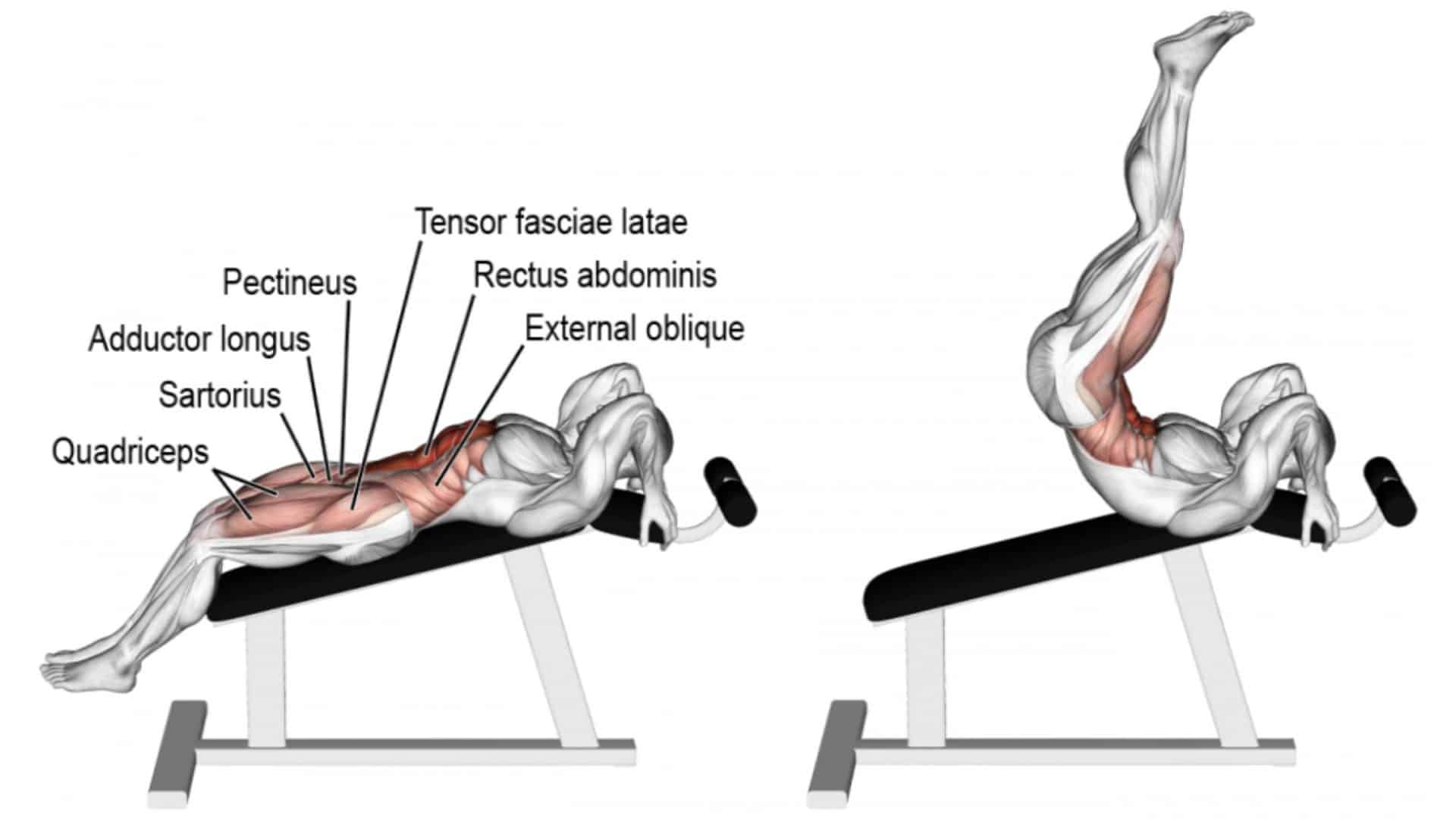
How To Do It
- Lie on your back on an inclined bench with your legs together.
- Place your hands beside your head and grip the bench for support.
- Keep your legs slightly bent, and slowly raise your legs and curl your hips off the bench by flexing your abdomen.
- Try to hold the contracted position, with your legs in the air.
- Inhale as you slowly lower your hips and legs to the starting position.
Tips
- Keep the movement slow and controlled. Do not use momentum.
- Do not let your heels rest on the floor.
3. Reverse Crunch
The reverse crunch is the best core exercise that primarily hits your lower abs.
During it, your upper body remains on the mat as you contract your abs to draw your legs towards your chest.
It offers many of the same benefits as the traditional crunch. As your neck and most of your back, stay on the ground, it’s thought to be easier on your spine.
Level: Beginner and Intermediate
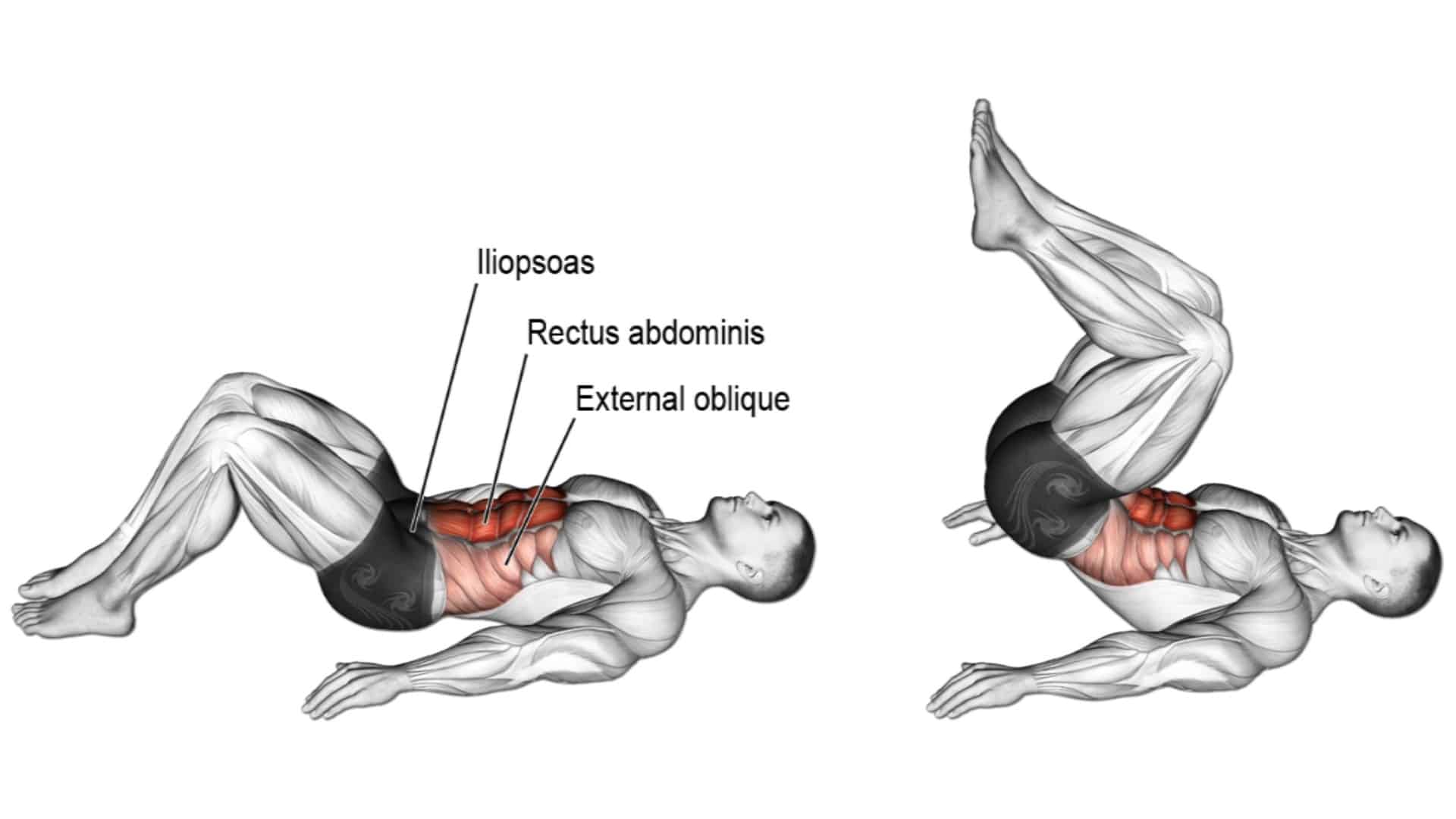
How To Do It
- Lie face up on the floor with your hands extended at your sides.
- Bend your knees so your hips and knees form 90-degree angles.
- Slowly bring your knees toward your chest, lifting your hips and glutes off the floor.
- Slowly lower your legs back to the starting position under control motion.
- Repeat for the desired number of repetitions.
Tips
- Try to maintain the bend in your knees throughout the movement.
- To make this exercise more difficult, perform it on a decline bench with your head on the high end.
4. Incline Reverse Crunch
The incline reverse crunch is similar to the traditional reverse crunch, except that it is performed on an incline bench.
Since it requires you to work against gravity, it puts more tension on the lower abs and is more difficult than the standard version.
Level: Intermediate and Advance
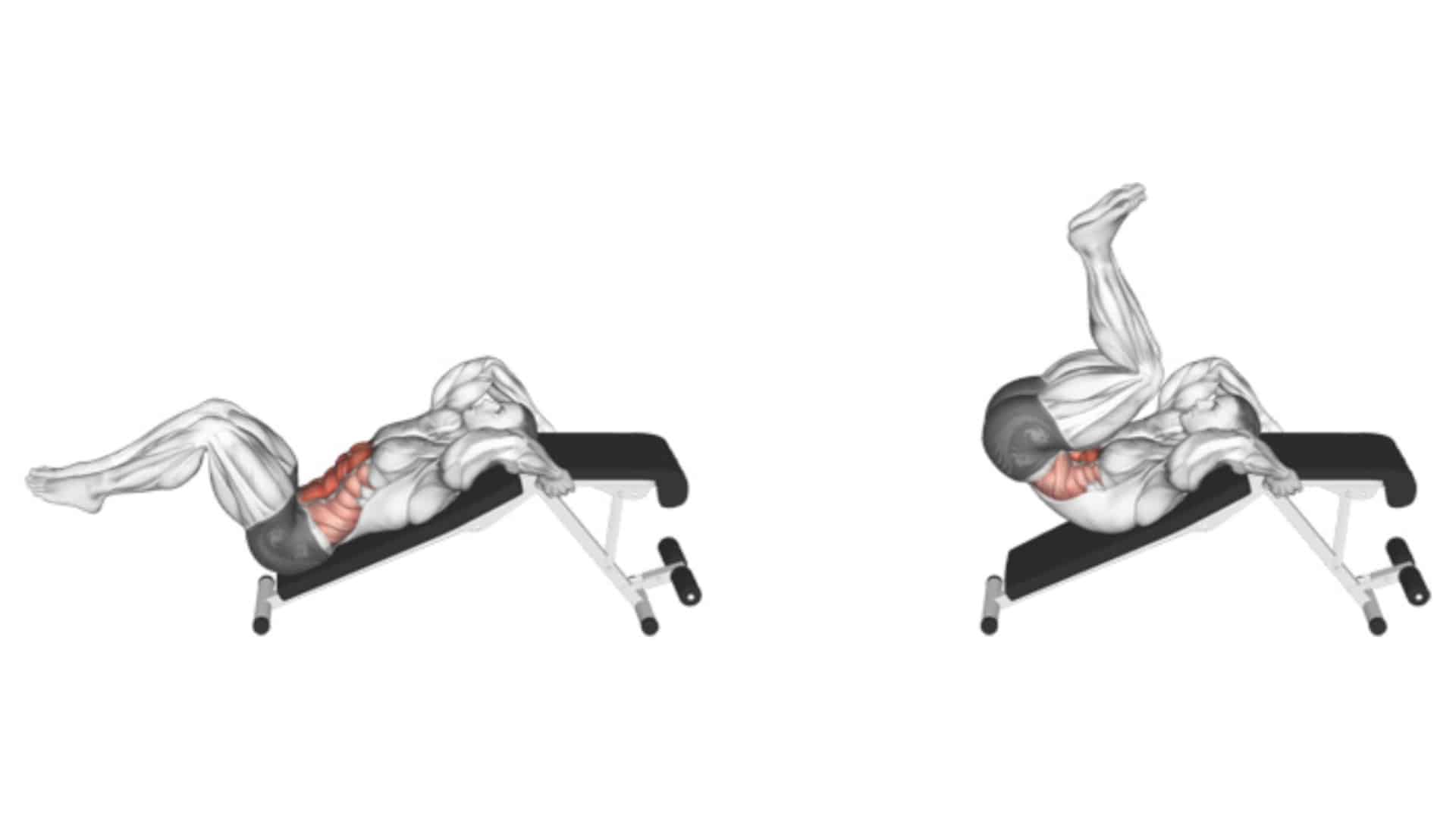
How To Do It
- Lie on an incline bench, with your head where your feet normally go.
- Hold on to the leg pads to hold your torso in place on the bench.
- Bend your hips and knees to 90-degree angles for the start position of the reverse crunch.
- Maintain the bend in your knees and hips, and flex your spine from the bottom to lift your hips up off the bench and curl your knees toward your head.
- Slowly reverse the motion to return your legs to the start position. Repeat for the desired number of repetitions.
Tips
- Keep the movement slow and controlled.
- Increase the incline by raising the bench to add more resistance.
5. Hanging Knee Raise
Hanging knee raises are a lower abs exercise that consists of lifting and lowering your knees to your chest while hanging on a pull-up bar.
This move mainly targets your abdominal muscles, including your obliques, but also works your hip flexors.
Raise your knees as high as possible to maximize muscular effort.
Level: Beginner and Intermediate
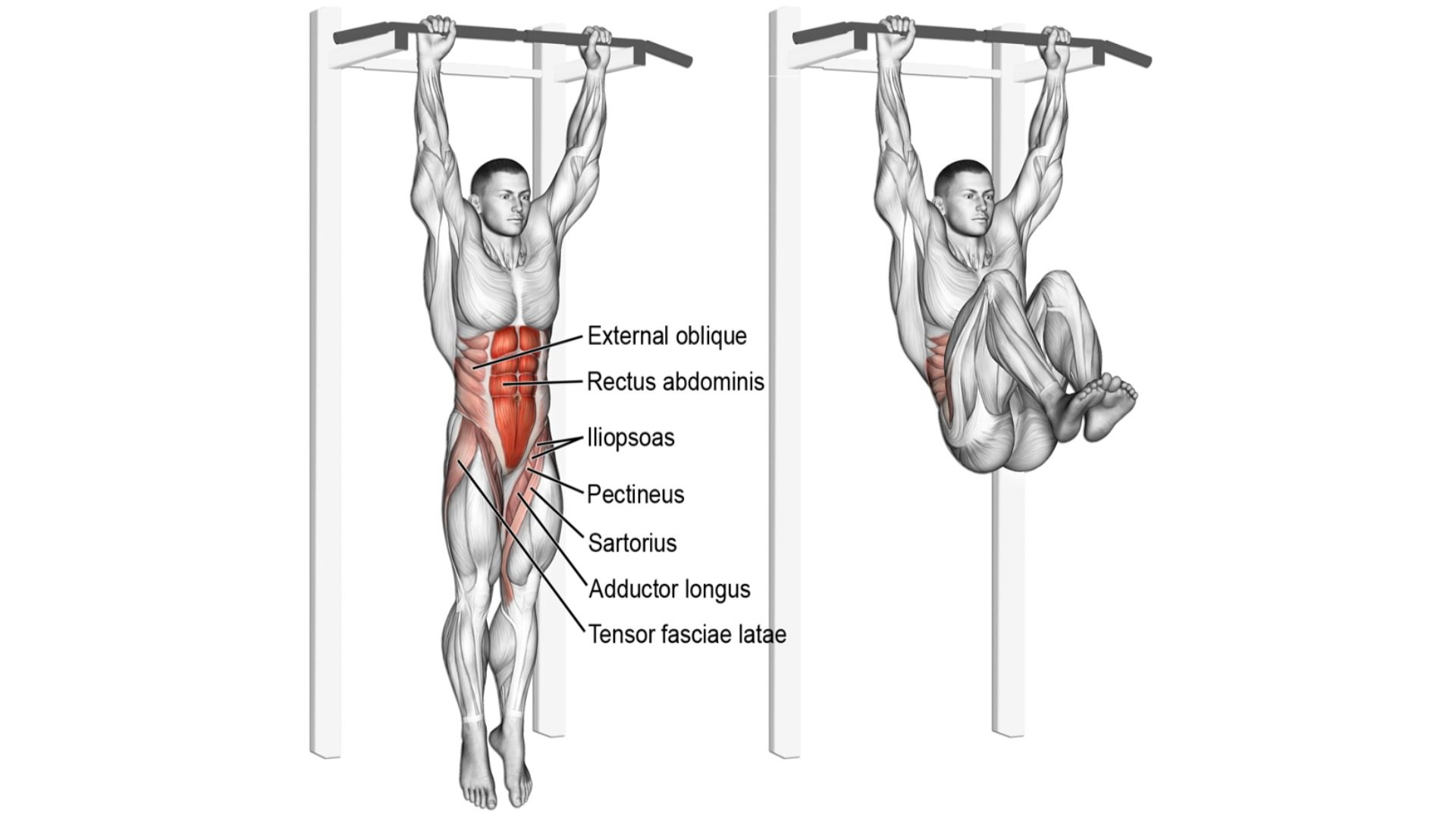
How To Do It
- Grab a bar with an overhead grip, with your hands slightly wider than shoulder-width. Your knees should be slightly bent.’
- Keep your core and glutes tight to keep your back and hips in the correct position
- Then lift your legs, bending your knees on the way up to pull your knees up toward your chest, while rounding your lower back to bring your glutes forward and up.
- Take a brief pause in this position, then slowly lower your legs back down to the start position without swinging. Inhale as you go down.
- Continue for the desired reps.
Tips
- As you lower your legs down, keep your knees slightly bent to maintain tension on the abs.
- To make it more difficult, straighten your legs (hanging straight leg raise), or hold a dumbbell between your feet.
6. Hanging Straight Leg Raise
A hanging leg raise is an exercise that primarily works the lower abs and hip flexors, and is a great addition to any fitness routine for overall core strength, spine health, and mobility.
In fact, studies have shown that hanging leg raises activated the rectus abdominis by 100% and activated the oblique muscles by 88%.
Level: Intermediate and advance
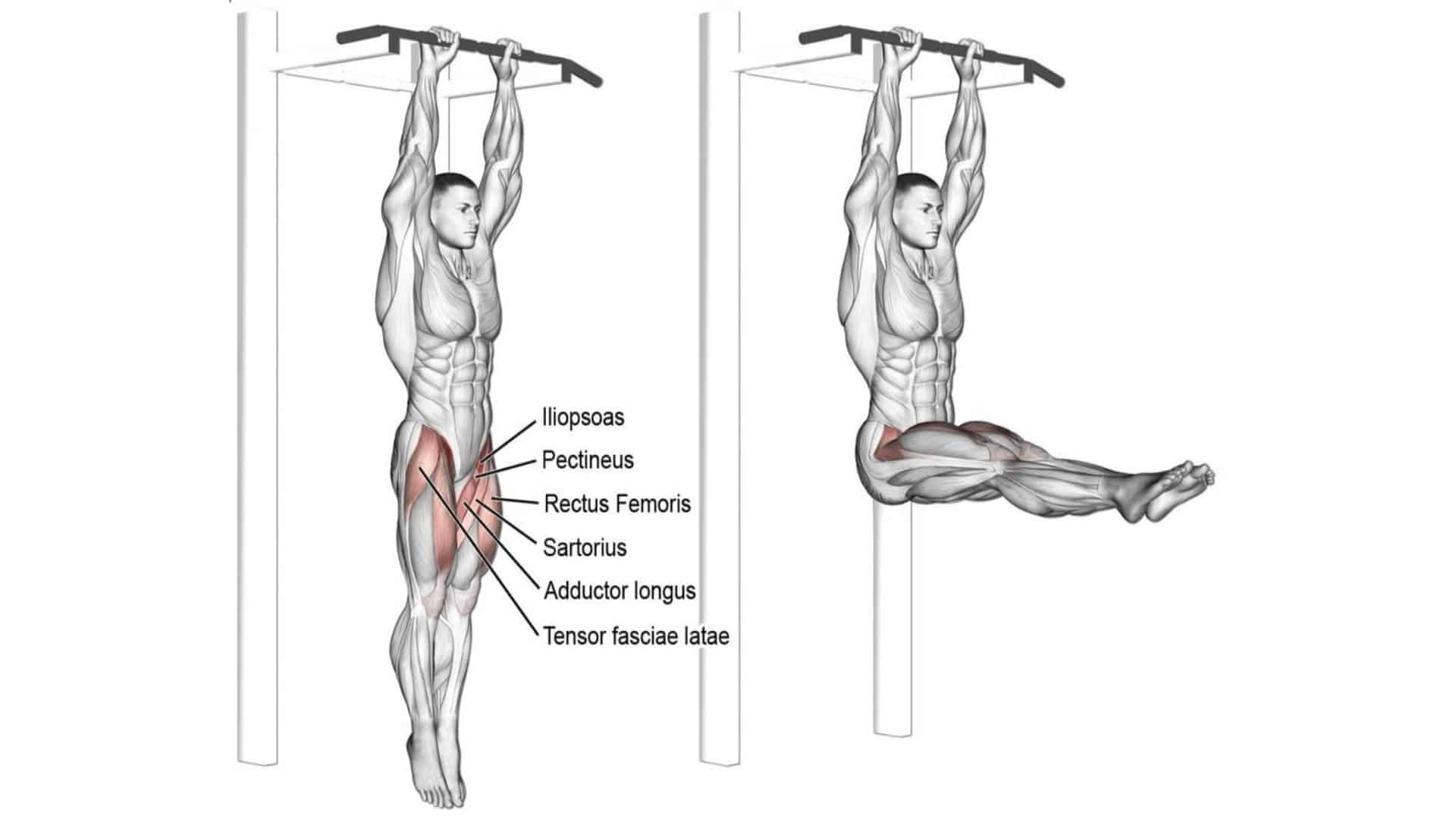
How To Do It
- Grab a bar with an overhead grip, with the hands slightly wider than shoulder-width.
- Keep your core and glutes tight to keep your back and hips in the correct position.
- Keeping your legs straight, lift both legs, toward your chest, using your hips and ab muscles. Exhale as you lift your legs up.
- Slowly lower your legs back down to the start position without swinging, inhaling as you go down.
Tips
- If you’re a beginner, do the bent knee variation and gradually straighten your legs.
- Do this without swaying or moving your body too much.
7. V-Up
The V-Up also known as a jackknife is a full-body move that works your core, legs, back, and shoulders. The exercise works the upper and lower abs muscles simultaneously.
A V-Up involves sitting on the floor or a mat and positioning the body in the shape of the letter “V. It requires you to lift the weight of both your arms and legs by using your abdominal muscles.
Level: Beginner and Intermediate
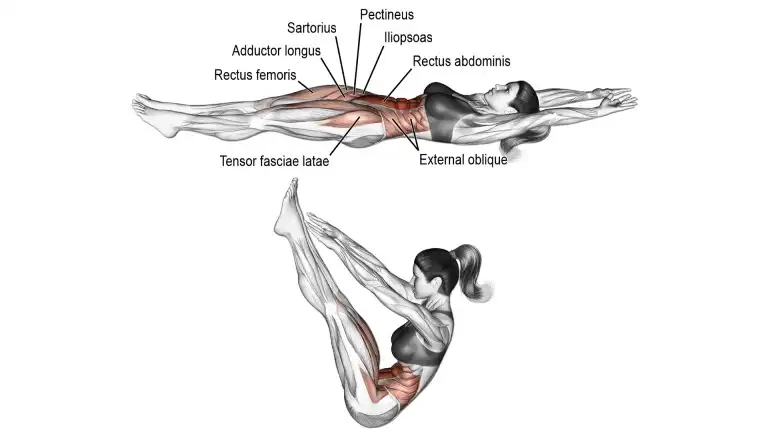
How To Do It
- Lie down on the floor on your back with your arms extended straight back behind your head. Your legs should also be extended.
- Exhale and bend at your waist while raising your legs and arms to meet in a jackknife movement. Try to hold the contracted position.
- Lower your arms and legs back to the starting position, inhaling as you do so.
- Repeat for the desired number of reps.
Tips
- Make sure the movement is slow and controlled.
- Try to keep your back straight while doing the V sit up.
8. Stability Ball Tuck
Stability Ball Tuck is a core stabilizing exercise that improves balance, strength, and flexibility throughout the hip and abdominal region.
It also targets the stabilizing muscles of the Oblique, hamstring, chest and shoulders.
The exercise requires you to maintain a high plank position while using your legs to roll a stability ball back and forth to your torso.
Level: Intermediate and advance
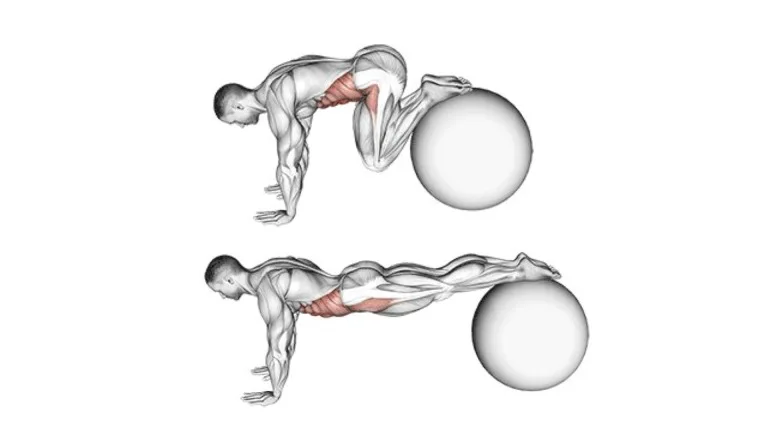
How To Do It
- Lie on the floor in a push-up position with your feet resting on top of an exercise ball.
- Tuck your knees in toward your chest while rolling the ball forward.
- Hold the tucked position for a second, and then return to the starting position by extending your legs back.
- Repeat for the desired number of reps.
Tips
- Keep your neck neutral.
- Do not allow your hips to sag throughout the movement.
9. Mountain Climber
Mountain climbers is an explosive bodyweight exercise that engages multiple muscle groups at once, helping to improve your balance, agility, coordination, strength, flexibility, and blood circulation.
It’s like exercising all of your muscles with one move.
Level: Beginner and Intermediate

How To Do It
- Start in the push-up position with your arms completely straight and directly beneath your shoulders.
- Your body should form a straight line from your shoulders to your ankles.
- Squeeze your abs, lift one foot off the floor and bring your knee up towards your chest while keeping your body in as straight of a line as possible.
- Return to the starting position and repeat the movement with your opposite leg.
Tips
- Don’t round your lower back.
- Don’t lift your hips too high. Your body should create a straight line from your shoulders to your ankles.
10. Hanging Windshield Wiper
Hanging windshield wiper gets its name from the posture adopted, that resembles the window wipers of a car, as an individual performs each rep.
The goal is to rotate the torso from one side to the other, whilst maintaining a horizontal position. Doing the windshield wiper movement helps to build lower abs and oblique.
Level: Intermediate and advance
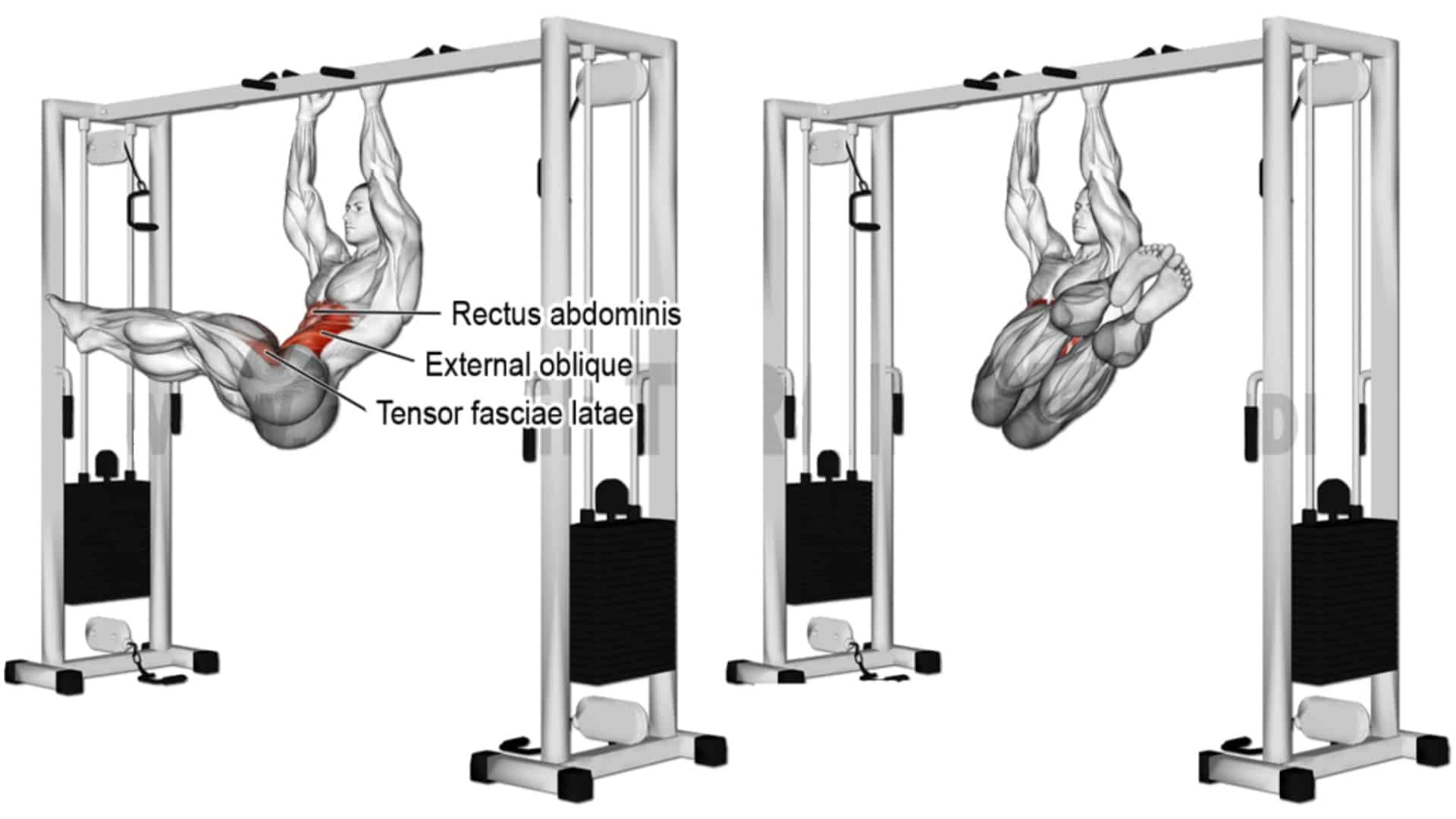
How To Do It
- Grab a bar with an overhead grip, with the hands slightly wider than shoulder-width.
- Lift your legs towards the bar. Keep your arms and legs straight. Your legs are perpendicular to your torso.
- Now, rotate your legs to one side.
- Slowly rotate your legs to the other side.
- Keep your legs as straight as possible.
- Continue for the desired reps.
Tips
- Do not lower your legs beyond feeling a mild stretch in your side.
- You can make the move easier by bending your knees.
- Do not rely on momentum, use your core strength.
Know More: Best Abs Workout That You Can Do at Gym
11. Seated Knee Up
Seated Knee up is an essential part of any lower abs workout routine.
If you want to build six-pack abs or simply increase your core strength, seated knee tucks are for you!
For most effective execution, keep the trunk stable and bring the knees as close to the chest as possible.
Level: Beginner and Intermediate

How To Do It
- Sit on the edge of a flat bench, legs hanging down with knees slightly bent, and grip the bench behind you.
- Lean backward and raise your legs a little off the floor, keeping them straight and together.
- Raise your knees up toward your chest, keeping your legs together.
- Lower your legs back down until your heels almost touch the floor.
Tips
- Keep your back straight and your feet off the floor.
- Make the seated leg raise more difficult by holding a dumbbell between your feet.
- Lean back slightly so that your torso makes a 45- to a 60-degree angle with the bench.
12. Barbell rollout
The barbell rollout is one of the best exercises for training lower abs that utilizes a barbell instead of an ab roller.
It is best performed with a barbell that has rotating collars and is considered more difficult than other ab roller variations.
Many lifters may not be able to perform a single rep at first, but once they can perform these for reps, they’ll be rewarded with a seriously strong core.
Level: Intermediate and Advance
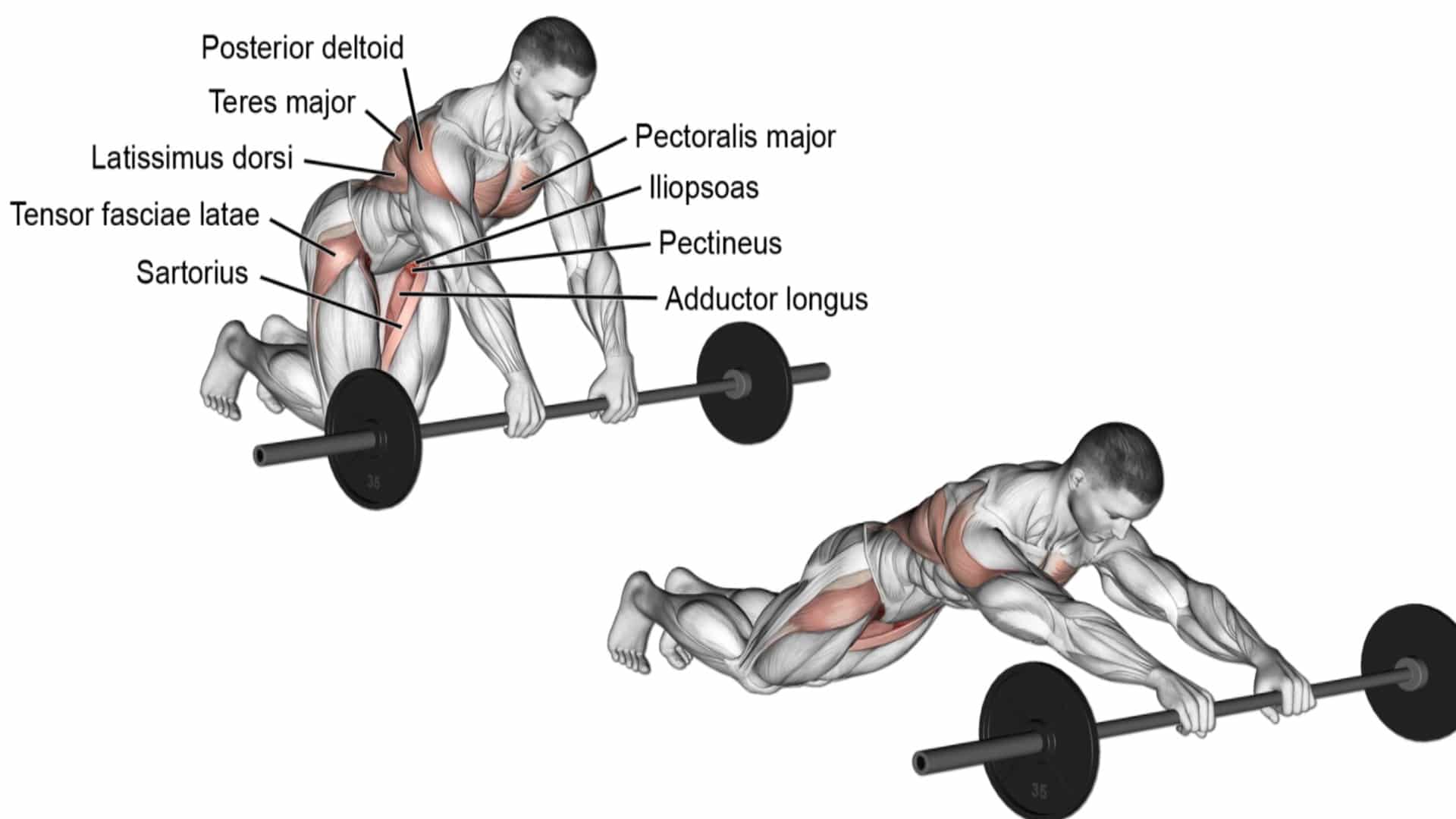
How To Do It
- Kneel on the floor in front of a loaded barbell and grab the barbell with an overhand, shoulder-width group.
- Your arms should be straight and your torso fairly upright in the start position.
- Allow the bar to roll forward as far as possible with just your knees and toes touching the floor while you maintain your grip on the bar.
- The goal is to be as flat as possible in the finish position, with your torso and upper legs parallel with the floor and hovering just a couple of inches above it.
- Then reverse the motion to pull the bar back toward your knees until your body is upright again.
Tips
- Squeeze your abs and glutes throughout the movement for stability.
- Move within a comfortable range of motion. You should not strain your lower back.
- Do not allow your hips to sag at any point during the movement.
13. Bicycle Crunch
The bicycle crunch is a great abs exercise that you should add to your home workout.
To make the exercise easier, you can make the angle between your legs smaller.
To make the exercise harder, you can make the angle between your legs bigger.
Level: Beginner and Intermediate

How To Do It
- Lie on your back with your legs straight.
- Put your hands behind your head and raise your feet and upper back off the floor.
- Slowly start raising your knees at about a 45-degree angle.
- Go through a bicycle pedaling motion with your legs, as you touch your elbow to the opposite knee, twisting it back and forth,
Tips
- Keep your neck straight and your back pressed against the floor.
- Make sure that you don’t pull your neck with your hands, else you can get a neck strain.
14. Dead Bug
The dead bug exercise is a popular way to build core strength and stabilization.
This move also helps prevent and relieve low back pain by strengthening the lower back and abs.
Level: Beginner

How To Do It
- Lie down with your face towards the ceiling and your arms and legs extended.
- Slowly extend your right leg out straight, and simultaneously drop your left arm overhead.
- Keep both a few inches from the ground.
- Squeeze your butt and keep your core engaged the entire time, lower back pressed into the floor.
- Bring your arm and leg back to the starting position.
- Repeat on the other side, extending your left leg and your right arm.
Tips
- Maintain a neutral spine.
- Engage your core and practice slow, controlled movements.
15. Flutter kick
Flutter kicks are an exercise that targets the lower abdominal wall, plus the hip flexors.
Although the traditional flutter kick can be done without equipment, you may want to consider enhancing the exercise by wearing ankle weights.
Level: Beginner and Intermediate
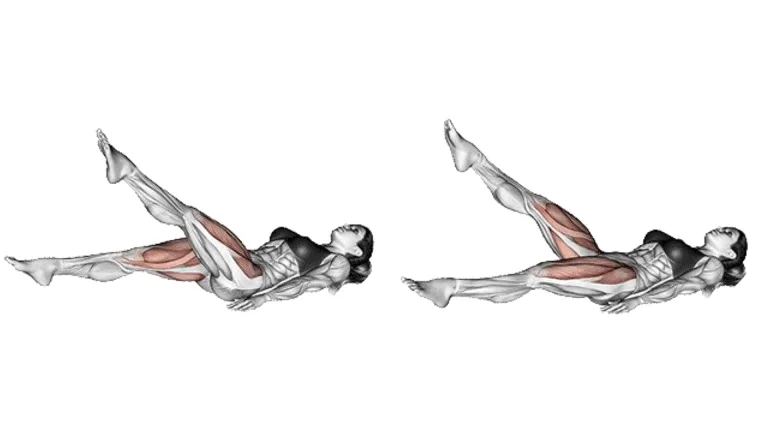
How To Do It
- Lie down on your back with your arms by your sides.
- Raise your legs so that your feet are about 6 inches from the floor.
- Lower your right leg a few inches while lifting your left one a few inches.
- Slowly reverse course, lifting your right leg a few inches and lowering your left leg a few inches.
- Repeat for 30-60 seconds.
16. Scissor Kicks
It is great for targeting both the lower abs and the obliques. The criss-cross motion will also give you a good stretch in your hip flexors and hamstrings.
Level: Beginner and Intermediate
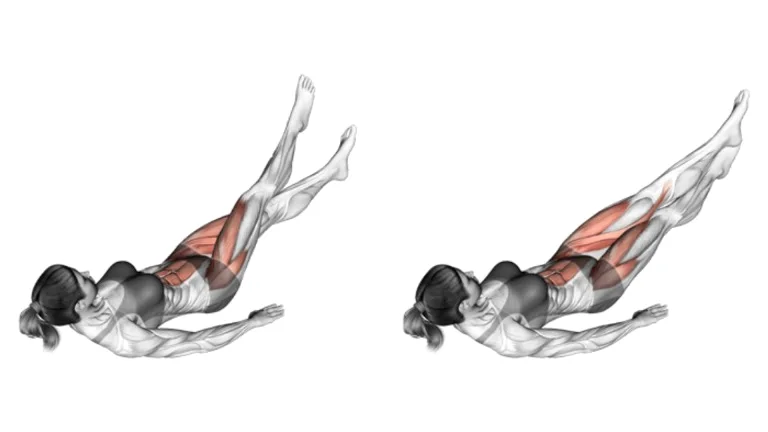
How To Do It
- Lie down on the floor with your hands behind your head and shoulders on the floor.
- Use your abs to lift your legs slightly off the floor and then scissor kick one leg up and one leg down.
- Alternate your legs for 30 seconds.
- Repeat for 30-60 seconds.
17. Toe Touches
A toe touch is a great exercise for beginners who want a more challenging workout.
Level: Beginner and Intermediate
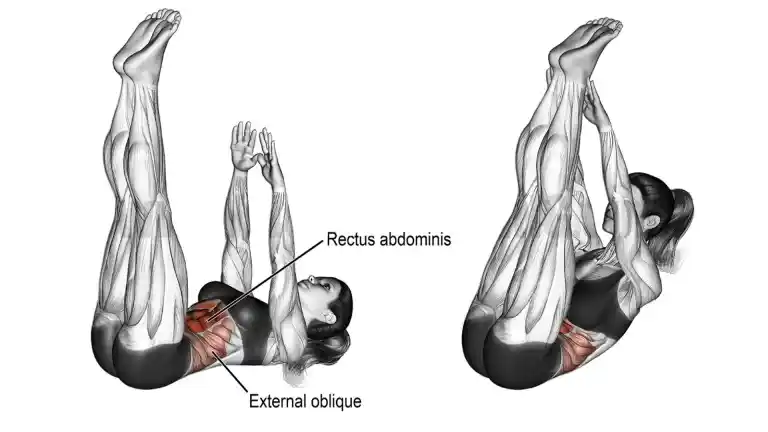
How To Do It
- Lie down on the floor with your hands behind your head and shoulders on the floor.
- Next, bring your legs up off the floor, straightening them to be perpendicular to your body. Point your toes away from your body.
- Lift your shoulders and head off the ground as you raise your hands toward your toes. Lower your hands and upper body back to the starting position. This is one rep.
- Repeat this process several times,
Tips
- Keep your abs tight and your legs perpendicular to the floor.
18. Hollow Hold
A hollow body hold is an isometric exercise that involves flexing your core muscles while remaining in a static position.
With proper form, both beginners and experienced fitness enthusiasts can safely perform this exercise and reap the benefits of a stronger core and lower abs.
Aside from being a highly effective exercise, this move requires very little space and no equipment.
Level: Beginner and Intermediate
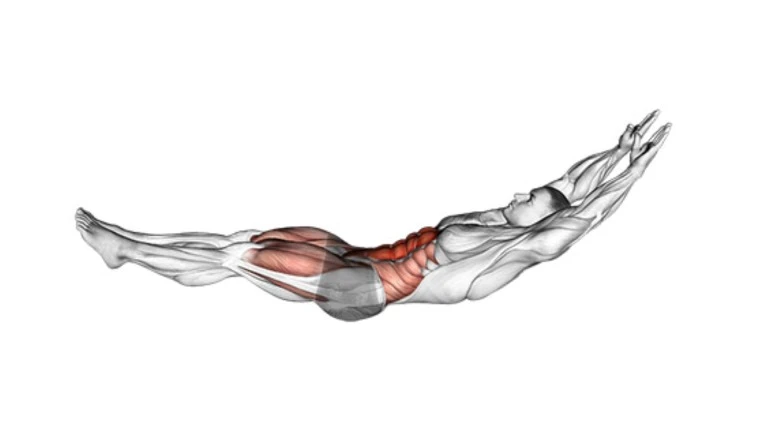
How To Do It
- Lie down on your back and stretch your arms above your head so that your biceps are next to your ears.
- Lift your feet, legs, shoulders, and arms off the floor and press your lower back into the ground.
- The only place you should touch the floor is your lumbar spine.
- Hold the pose for a few seconds.
FAQs On Lower Abs Training
What exercise is best for lower abs?
Here are the best exercises for lower abs to build impressive six-pack abs and a stronger core.
- Lying Straight Leg Raise
- Hip Lift
- Reverse Crunch
- Hanging Knee Raise
- V-Up
- Stability Ball Tuck
- Mountain Climber
- Seated Knee Up
- Bicycle Crunch
- Dead Bug
How do I get my lower abs to show?
Healthy eating is the best way to lose fat around the lower belly. You can speed up the fat burning process by doing cardio and strength training. This will help you reveal your lower abs faster.
Are lower abs harder to get?
Yes, lower abs are more difficult to achieve than upper abs. This is because the upper abs are the first area of the abdomen to reveal themselves when you enter into a calorie deficit, so they will show up before the lower abs.
How do I target my lower 2 abs?
Here are the best exercises to target the lower two sections of the abs in order to build impressive six-pack abs and a stronger core.
- Hip Lift
- Scissor kick
- Flutter kicks
- Slider knee tuck
- Reverse Crunch
- Hanging Leg Raise
Can I do lower abs exercises everyday?
No, you shouldn’t train your lower abs every day. Your abs need rest, and training them every day won’t give them enough recovery time.
Most beginners will notice improvement in their abdominal muscles after training them directly two to three days per week. Since many strength movements involve the core and abdominal muscles.
Conclusion
For anyone who is interested in building abdominal muscles and gaining strength, these lower abs exercises are highly recommended.
It not only allows for targeted lower abs muscle development, but also provides overall abs muscle development. It is easy to do and requires no more scientific details.
You should start to see improvements in the strength and appearance of your lower abs if you continue to practice these exercises.
Thanks for reading, enjoy your workout!
Stay Fit, Life a Happy and Healthy Life
References
- Abdominal fat and what to do about it. (2019). health.harvard.edu/staying-healthy/abdominal-fat-and-what-to-do-about-it
- Butler A. (2019). Personal interview.
- Hsu SL, et al. (2018). Effects of core strength training on core stability. jstage.jst.go.jp/article/jpts/30/8/30_jpts-2018-146/_article
- Core exercise workout: 12 tips for exercising safely and effectively. (2016). health.harvard.edu/staying-healthy/core-exercise-workout-12-tips-for-exercising-safely-and-effectively
- Grgic J, et al. (2018). Effect of resistance training frequency on gains in muscular strength: A systematic review and meta-analysis. pubmed.ncbi.nlm.nih.gov/29470825/
20 Best Lower Abs Exercises (EASIEST TO HARDEST)

Manish brings over 10 years of hands-on experience in weight lifting and fat loss to fitness coaching. He specializes in gym-based training and has a lot of knowledge about exercise, lifting technique, biomechanics, and more.
Through “Fit Life Regime,” he generously shares the insights he’s gained over a decade in the field. His goal is to equip others with the knowledge to start their own fitness journey.

Hey! Great one. Going through this blog, I came to know many new abs exercises and it’s effects. Very eager to read more blogs of yours and learn more new exercises.